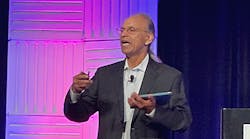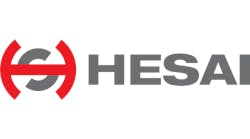Andy Chatha, president and CEO of ARC Advisory Group, kicks off the ARC Industry Forum in Orlando
After more than two years of online gatherings, ARC Industry Forum 2022 roared back with an in-person event on June 6-9 that racked up almost as much attendance as any of its pre-pandemic editions. The 26th annual conference in Orlando featured 875 attendees, who attended 70 sessions in five tracks by 200 speakers, and enjoyed face-to-face presentations keynotes and exhibits about digitalization, IT-OT convergence, cybersecurity and other vital topics during the event’s three and a half days.
“Our personal and business lives all got more complicated in past couple of years,” said Andy Chatha, president and CEO of ARC Advisory Group in his introduction. “And now, we’re facing volatile challenges beyond COVID-19 in the form of supply chain disruptions and a brutal war.”
In the first end-user keynote, Dustin Olson, CEO of PureCycle Technologies in Orlando, reported on its “born digital” method for recycling polypropylene, which employs less costly digitalized controls to manage chemicals, heat and solubility, remove contaminants, return the light plastic to a purer and more usable state, and give it greater circularity as a recyclable material. PureCycle employs DeltaV automation, asset management and augmented reality devices from Emerson. Its first commercial plant is scheduled to start up in six months, with two more opening a year later, and it expects to be processing a billion pounds of plastic by 2025.
Andy Chatha, president and CEO at ARC (left), moderates the digital transformation panel at ARC Industry Forum 2022 on June 7 in Orlando with panelists (l. to r.) Whit McConnell, chief automation and process control engineer at ExxonMobil, Nathan Pettus, president of process systems and solutions at Emerson, Linda Rae, general manager of power generation and oil and gas for GE Digital, and Dustin Olson, CEO of PureCycle Technologies
“We built a digital foundation, so we can bolt it onto our plants in the future, and monitor performance at those locations,” explained Olson. “We’re also going to maintain an integration hub at our headquarters, so we can see when a valve is likely to fail in several weeks, and determine how to help down the road.”
To accomplish a digital transformation for a company or organization, Greg Gorbach, VP at ARC, added that its leaders must pay attention to seven primary characteristics:
- Hyperconnectvity of sensors, assets, devices, processes and people;
- Data, advanced analytics and cognitive technology to generate more value from resources, develop new products, improve resilience and agility, and develop a data-focused culture;
- Talent and the ability to use 21st Century skills, such as remote- and connected-worker capabilities;
- Emphasis on climate and societal impact;
- Emerging digital business models for stronger interactions, changing business processes and structure, customer-centric excellence;
- Digitalized supply networks that are intelligent, dynamic and resilient; and
- Software, software, software.
Gorbach profiled more than two dozen firms that exemplify these attributes in the newly published “ARC Digital Transformtion Top 25 Report.”
Executive panelists (left to right) Nathan Pettus, president of process systems and solutions at Emerson; Linda Rae, general manager of power generation and oil & gas at GE Digital; and Dustin Olson, CEO of PureCycle Technologies, detail their digitalization journeys at ARC Industry Forum 2022 on June 7 in Orlando.
During the panel discussion that followed, Linda Rae, general manager of power generation and oil and gas at GE Digital, explained, “Digitalization is the key to enabling energy transition, and enabling gas to fill in the gaps where renewables can't. However, energy transition is also the ultimate multivariable problem because all fuel sources must be coordinated and utilized for generation and transmission, and we need digitalized tools to do it.”
In the next day’s general session, Mike Tomasco, VP of digital manufacturing at Pfizer, showed how its digital transformation enabled it to develop its version of the COVID-19 vaccine in record time. Pfizer expanded its Digital Operations Center, which contributed to it produce its vaccine in just nine months. “Do something, and if that doesn’t work, then try something else,” advised Tomasco. “Make decisions and take action. It’s better than overthinking and never making a decision. You can’t make progress unless you try. Also, failure is fine. Just learn from it and try something else.”
In other news at ARC, Ted Masters, CEO of the FieldComm Group, reported it’s wrapping up its contribution to the Ethernet-Advanced Physical Layer (Ethernet-APL) specification, which will enable its existing HART-Internet protocol (HART-IP) specification. The group is also working on a next-generation project that will use Ethernet-APL in conjunction with OPC UA and Process Automation-Device Information Mode (PA-DIM) to develop an initial, native information model for delivering data straight to cloud-computing services model, which will let users unlock field information without having to translate it.
OPC Foundation presented an update on it UAFX C2C multi-vendor demo that allows devices from different vendors to talk to each other, and provides a dashboard for monitoring all related controllers and connections. Its communications infrastructure consists of Ethernet switches, Ethernet time-sensitive networking (TSN) and a 5G testbed from B&R, Belden/Hirschmann, Huawei, Moxa, Phoenix Contact, Schneider Electric and Siemens. The demo’s controllers are from ABB, Beckhoff, B&R, Bosch Rexroth, Emerson, Festo, Honeywell, Kuka, Mitsubishi, Omron, Phoenix Contact, Rockwell Automation, Schneider Electric, Siemens, Unified Automation, Wago and Yokogawa.
Hexagon AB reported that its PPM division was renamed Hexagon’s Asset Lifecycle Intelligence to achieve its vision of “Smart Digital Reality for Autonomous Industrial Facilities,” and more accurately represent its evolving offerings. These include the recent addition of HxGN EAM (formerly Infor EAM) software, which has joined Hexagon’s suite that digitizes and optimizes maintenance operations to reach optimum operational efficiency throughout asset lifecycles.
Schneider Electric demonstrated how its working with UniversalAutomation.org (UAO), an independent, not-for-profit, non-competitive association to manage a shared-source, runtime, reference architecture of the IEC 61499 standard. It also reported how its collaborating with Intel to use its EcoStruxure Automation Expert, Version 22.0, software to develop a distributed control node (DCN) software framework to enable IT and OT convergence.
For more coverage of ARC Industry Forum, including complete presentations and videos, visit www.arcweb.com/events/arc-industry-forum-orlando




